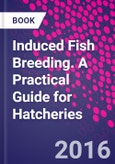Induced Fish Breeding: A Practical Guide for Hatcheries takes a successive approach to explaining the use of breeding technology with proven scientific methods. It provides real-life examples for the purpose of maximizing fish and seed production to support overall sustainability in aquaculture. It is a concise reference to understanding the latest developments in the field, useful for anyone who is involved in fisheries or hatchery management as well as researchers and students who need to understand the technology.
A practice originally developed to produce quality seed in captivity, induced breeding has made great strides in fish populations for India. The book offers a practical and succinct overview-from existing methods and operations to recent trends and their impacts on aquaculture for the future.
Please Note: This is an On Demand product, delivery may take up to 11 working days after payment has been received.
Table of Contents
Part I: Induced Breeding-A Scientific Approach Towards Modern Fish Breeding Procedure
Part I. Induced Breeding-A Scientific Approach Towards Modern Fish Breeding Procedure
1. Eco-Hatchery for Fish Breeding of Carps in Captivity
2. Reproductive Cycle, Maturation, and Spawning
3. Hybridization
4. Selective Breeding
5. Negative Aspects of Breeding Practice
6. Influence of Ecological Factors on Maturation, Spawning, and Hatching of Carps
Part II: Case Studies
7. Current Status of Hatchery Operations in Some Leading Seed-Producing States of India and Its Impact on Aquaculture
8. Seed Resources and Supply Chain in Some Asian Countries
9. Review of Freshwater Prawn Hatchery Operation in Some Asian Countries
10. Genetic Variation and Phylogenetic Relationship Among the Two Different Stocks of Catla (Catla catla) in the Indian State of Orissa Based on RAPD Profiles
Part III: Innovations
11. Approaches to Genetic Improvement
12. Conservation Hatchery and Supplementation-A Recent Approach to Sustainable Aquaculture








